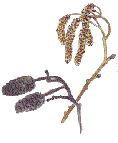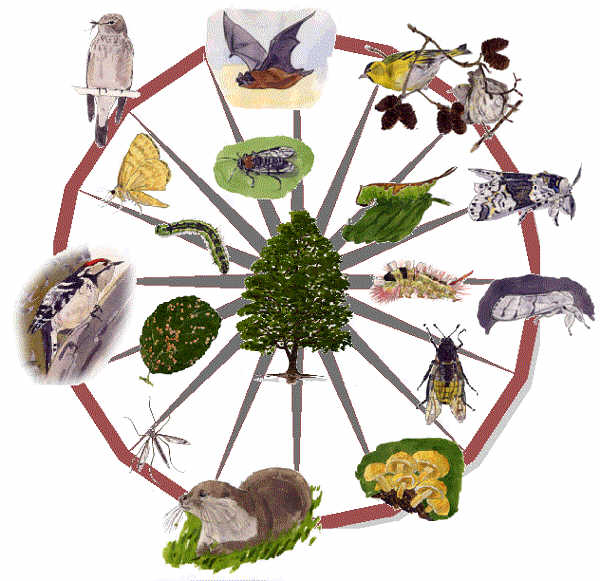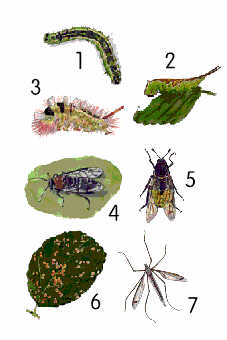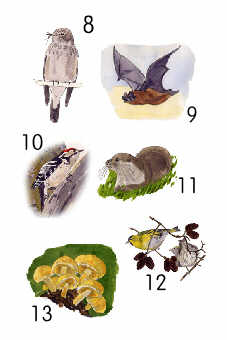| The
habitat that develops along the floor of a valley consists of a diverse
community of plants and animals. The interactions between the members of
this community are too complex to describe in full. Focussing
on one tree species provides an insight into this complexity.
|
|||||||
|
|
Alder (Alnus glutinosa) is a typical tree of the waterside. It is a medium sized tree with a purple hue to its fresh growth. The dark green leaves are characteristically indented at the apex, and clusters of woody cones persist on the twigs through the winter. Spring sees the opening of the male catkins, revealing yellow pollen beneath the purple scales. |
 |
|||||
|
The Alder tree The leaves and wood of the alder tree are the initial source of energy that turns the wheel of life. |
|||||||

|
|||||||
| Within
the network of branches, twigs and leaves, can be found a wide range of
invertebrates that chew on the foliage or the wood. Others will be sucking
up fluids from the tree's tissues. Close examination of the leaves could
reveal some remarkable moth caterpillars. Dingy Shell (1. Euchoeca nebulata)
is only found on Alder. This caterpillar blends well with the background,
but the Alder Kitten (2. Furcula bicuspis) combines splendid counter-shading
with the option of adopting a threat posture with raised head and tails.
The Pale Tussock (3. Calliteara pudibunda) is more conspicuous, relying
on its tufts of hairs to deter predators and parasitic wasps. Not all caterpillars are destined to be moths or butterflies. Those with distinct eye spots on the head might belong to one of two species of sawfly that are associated with alder trees. Alder Sawfly (4. Croesus septentrionalis ) and Cimbex connatus (5). Some leaves are roughened by the pinkish galls of mites (6. Eriophyidae) which penetrate the leaf surface and cause its cells to grow the pimple that provides food and shelter for the invader. The Giant Cranefly (7. Tipula maxima) uses the mud at the stream margins as a nursery for its larvae. |
 |
||||||
 |
Adult
insects that take to the wing can become food for Spotted Flycatchers (8.
Muscicapa striata) during the day or the Noctule Bat (9. Nyctalus
noctula) at night. Beneath the bark, other insect larvae will be concealed,
but the Lesser Spotted Woodpecker (10. Dendrocopus minor) will search
them out. At the base of the tree, the roots thread through the bank and
help to prevent erosion. Occasionally, a hollow will develop beneath the
tree that can be used as an Otter's holt (11. Lutra lutra). The leaves which fall from the Alder tree and sink to the river bed are food for scavenging Freshwater Shrimps (Gammarus spp.) and other detritus feeders. They in turn are eaten by the fish which are the main part of the otter's diet. The leafless branches of the tree in winter will be visited by Siskins (12. Carduelis spinus) that come to prize the seeds from the clusters of cones. Dead wood is also consumed by fungi (13. Pholiota alnicola), releasing into the soil important plant nutrients that will then return to the living tissue of the tree by way of its roots |
||||||
|
........
and so the wheel turns.
|
|||||||

|
The Alder tree
|
 |
|||||
|
Uses
|
Folk
Lore
|
|
|